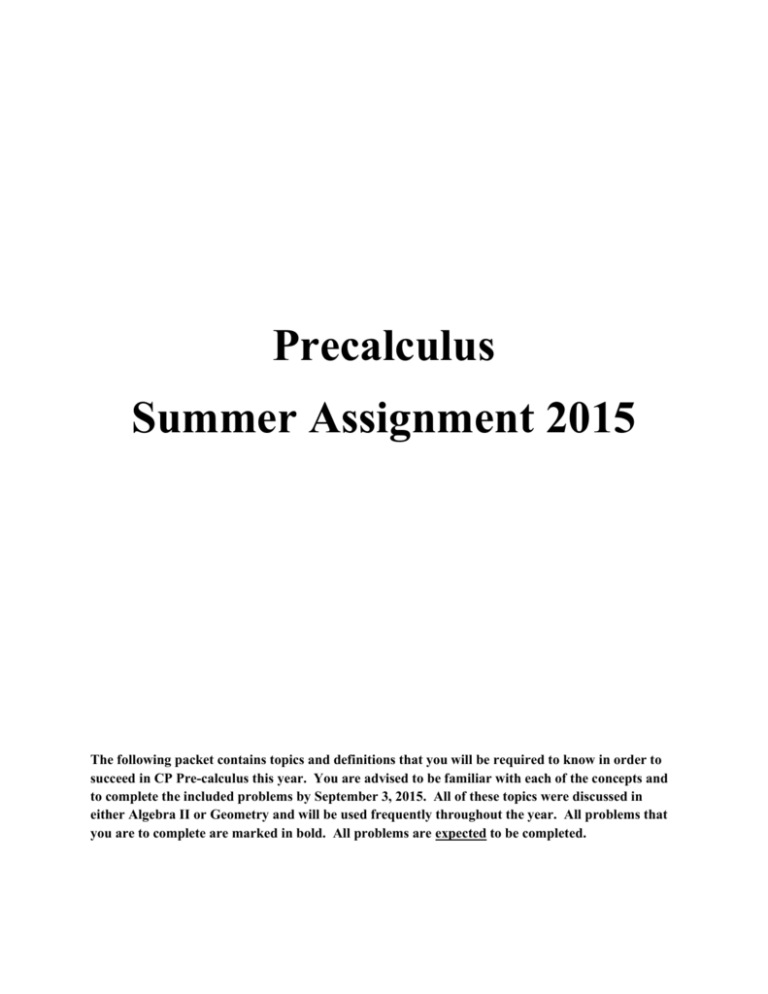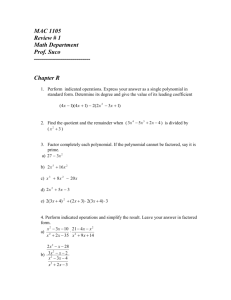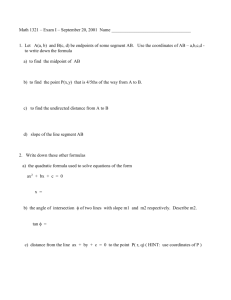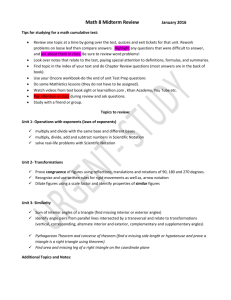Precalculus Summer Assignment 2015
advertisement

Precalculus Summer Assignment 2015 The following packet contains topics and definitions that you will be required to know in order to succeed in CP Pre-calculus this year. You are advised to be familiar with each of the concepts and to complete the included problems by September 3, 2015. All of these topics were discussed in either Algebra II or Geometry and will be used frequently throughout the year. All problems that you are to complete are marked in bold. All problems are expected to be completed. Section 1: Coordinates and Planes Midpoints: The midpoint of the interval with endpoints a and b is found by taking the average of the endpoints. 𝑀= 𝑎+𝑏 2 The midpoint of a segment with endpoints at (x1, y1) and (x2, y2) is found by taking the average of the two coordinate values. 𝑥1 + 𝑥2 𝑦1 + 𝑦2 𝑀=( , ) 2 2 Find the midpoint M of the segment with endpoints C (4, 4) and D (-2, 6). Distance: The distance d between any two points x1 and x2 on a real number line is: 𝑑 = |𝑥1− 𝑥2 | = √(𝑥2 − 𝑥1 )2 The distance d between any two points (x1, y1) and (x2, y2) on a Cartesian plane is: 𝑑 = √(𝑥2 − 𝑥1 )2 + (𝑦2 − 𝑦1 )2 Find the distance between each pair of points: (6, -2) and (-5, 12) (5.8, -1) and (7, -4) Section 2: Lines Lines: Slope: 𝑦2 −𝑦1 𝑥2 −𝑥1 Slope Intercept Form: y = mx + b Standard Form: ax + by = c Point-Slope Form: y - y1 = m(x – x1) Intercepts: In order to find the x-intercept(s) of an equation, you have to set y equal to zero and solve the equation for x. In order to find the y-intercepts of an equation, you have to set x equal to zero and solve the equation for y. Parallel Lines: Two lines whose graphs have the same slope. Perpendicular Lines: Two lines whose graphs have opposite reciprocal slopes. Find the slope of the lines passing through each set of points: 𝟏 (𝟔, 𝟏𝟐)𝒂𝒏𝒅 (−𝟔, −𝟐) Find the slope of the line: 𝟏 𝟏 (− 𝟑 , 𝟎) 𝒂𝒏𝒅 (− 𝟐 , − 𝟐) Find the F Find the slope of the following Line: y 𝟑𝒙 + 𝟓𝒚 = −𝟏𝟓 4 2 –4 –2 O –2 –4 2 4 x Write the equation of the line in standard Find the point-slope form of the line form for a slope of -8 and through (-2, -2) through (-6, -4) and (2, -5). Write the equation of the line in slope-intercept Write the equation of the horizontal form through (−𝟏𝟎, −𝟑) and (−𝟏, 𝟏). line through (−𝟑, −𝟏). Graph the equation of 6x + 5y = 30 using the x- and y-intercepts. 𝟑 Graph 𝒚 = − 𝟒 𝒙 − 𝟐 Find the equation of the line that is parallel Find the equation of the line perpendicular to 𝒚 = − 𝟑𝒙 + 𝟒 and goes through (−𝟒, 𝟔). to 𝒚 = − 𝟒 𝒙 + 𝟏 and goes through (2, 6). 𝟓 Give the slope-intercept form for the equation of the line that is perpendicular to 𝟕𝒙 + 𝟑𝒚 = 𝟏𝟖 and contains (𝟔, 𝟖). Which two lines are parallel? I. II. III. What must be true about the slopes of two perpendicular lines, neither of which is vertical? Section 3: Functions Function: A function is a relation in which each value for the independent variable corresponds to a unique value of the dependent variable. A vertical-line test can be used on the graph of a relation in order to determine if the relation is a function. If a vertical-line can be drawn on the graph of a relation so that the line intersects 2 points on the graph, then the relation is not a function. Domain: A list of all possible values for the independent variable. Range: A list of all possible values for the dependent variable. Write the ordered pairs for the relation. Find the domain and range and determine whether Suppose 𝒇(𝒙) = 𝟒𝒙 − 𝟐 and 𝒈(𝒙) = −𝟐𝒙 + 𝟏. 𝒇(𝟓) Find the value of 𝒈(−𝟑). the relation is a function. y 4 2 –4 –2 O 2 4 x –2 Evaluate each of the following for the function 𝒇(𝒙) = 𝒙𝟐 − 𝟒𝒙 + 𝟕: 𝒇(𝟒) = 𝒇(−𝟑) = –4 𝒇 Find (𝒇 + 𝒈)(𝒙), (𝒇 − 𝒈)(𝒙), (𝒇𝒈)(𝒙), (𝒈) (𝒙), (𝒇о𝒈)(𝒙), (𝒈о𝒇)(𝒙), (𝒇𝒈)(−𝟑), (𝒇 + 𝒈)(𝟓) for 𝒇(𝒙) = 𝒙𝟐 − 𝟒 𝒂𝒏𝒅 𝒈(𝒙) = 𝒙 + 𝟐 Sketch the graph of each functions: 𝒇(𝒙) = |𝒙| 𝒇(𝒙) = 𝒙 𝒇(𝒙) = 𝒙𝟐 𝒇(𝒙) = √𝒙 𝟏 𝒙 𝒇(𝒙) = 𝒙𝟑 𝒇(𝒙) = Section 4: Polynomials Properties of Exponents: 1. Whole number exponents: 2. Zero exponents: 𝑥 𝑛 = 𝑥 ∙ 𝑥 ∙ 𝑥 ∙ … ∙ 𝑥 (n factors of x) 𝑥 0 = 1, 𝑥 ≠ 0 3. Negative Exponents: 𝑥 −𝑛 = 1 𝑥𝑛 𝑛 √𝑥 = 𝑎 → 𝑥 = 𝑎𝑛 4. Radicals (principal nth root): 5. Rational exponents: 𝑥 1⁄ 𝑛 6. Rational exponents: 𝑥 𝑚⁄ 𝑛 𝑛 = √𝑥 𝑛 = √𝑥 𝑚 Operations with Exponents: 1. Multiplying like bases: 𝑥 𝑛 𝑥 𝑚 = 𝑥 𝑚+𝑛 2. Dividing like bases: 𝑥𝑚 𝑥𝑛 3. Removing parentheses: (𝑥𝑦)𝑛 = 𝑥 𝑛 𝑦 𝑛 = 𝑥 𝑚−𝑛 𝑥 𝑛 𝑦 ( ) = 𝑥𝑛 𝑦𝑛 (𝑥 𝑛 )𝑚 = 𝑥 𝑛𝑚 Simplify each of the following expressions: 𝟐𝒂𝟐 𝒃−𝟒 ∙ 𝟒𝒂−𝟖 𝒃𝟔 2𝑥 3 + 6𝑥 4𝑥 𝟑 𝟑𝒙𝟒 ) 𝒚−𝟐 𝟖𝒂𝟐 𝒃−𝟐 𝟒𝒂𝟒 𝒄−𝟓 ( 5𝑥 − 4 5𝑥 3𝑥𝑦 3 + 𝑥 2 𝑦 2 𝑥𝑦 Solve each of the following by Factoring: 𝟑𝒙𝟐 − 𝟔𝒙 = 𝟎 𝒙𝟐 − 𝟏𝟑𝒙 + 𝟒𝟐 = 0 𝟒𝒙𝟐 + 𝟐𝟎𝒙 − 𝟏𝟐 𝒙𝟐 − 𝟐𝒙 − 𝟑𝟓 = 𝟎 𝟗𝒙𝟐 − 𝟒𝟐𝒙 + 𝟒𝟗 𝟒𝒙𝟐 − 𝟏𝟒𝟒 = 0 𝟑𝒙𝟐 − 𝟏𝟔𝒙 + 𝟓 𝒙𝟐 + 𝟗 = 𝟎 Solve each of the following by using the Quadratic Formula: 𝑥 = 𝒙𝟐 + 𝟐𝒙 + 𝟒 = 𝟎 −𝑏±√𝑏2 −4𝑎𝑐 2𝑎 𝟖𝒙𝟐 − 𝟏𝟎𝒙 − 𝟑 = 0 Expand each of the following (hint: FOIL): (𝒙 + 𝟒)𝟐 (𝒙 − 𝟐)𝟑 Divide the following expression by both polynomial long division and synthetic division. Section V: Right Triangle Trigonometry Special Right Triangles 45-45-90: In a 45-45-90 triangle, the side lengths have a ratio of 𝑎 ∶ 𝑎 ∶ 𝑎√2. 30-60-90: In a 30-60-90 triangle, the side lengths have a ratio of 𝑎 ∶ 𝑎√3 ∶ 2𝑎 Trigonometry: For any right triangle: 𝑜𝑝𝑝𝑜𝑠𝑖𝑡𝑒 𝑠𝑖𝑑𝑒 𝑠𝑖𝑛𝜃 = ℎ𝑦𝑝𝑜𝑡𝑒𝑛𝑢𝑠𝑒 𝑐𝑜𝑠𝜃 = 𝑎𝑑𝑗𝑎𝑐𝑒𝑛𝑡 𝑠𝑖𝑑𝑒 ℎ𝑦𝑝𝑜𝑡𝑒𝑛𝑢𝑠𝑒 𝑜𝑝𝑝𝑜𝑠𝑖𝑡𝑒 𝑠𝑖𝑑𝑒 𝑡𝑎𝑛𝜃 = 𝑎𝑑𝑗𝑎𝑐𝑒𝑛𝑡 𝑠𝑖𝑑𝑒 Pythagorean Theorem: In a right triangle with legs a and b and hypotenuse c, then 𝑎2 + 𝑏 2 = 𝑐 2 . Find the length of the missing sides of the figures. Leave your answer in simplest radical form. 15 6 6 Not drawn to scale 8 16 6 45° Not drawn to scale x 60° 12 Not drawn to scale In triangle ABC, is a right angle and leave it in simplest radical form. 45. Find BC. If you answer is not an integer, C x 11 ft B y 30° 20 A Not drawn to scale Not drawn to scale A piece of art is in the shape of an equilateral triangle with sides of 7 in. Find the area of the piece of art. Round your answer to the nearest tenth. Write the ratios for sin A, cos A, and tan A. A 5 4 C 3 Not drawn to scale B





